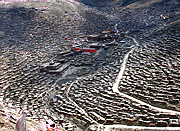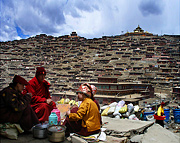China Trekking
Serthar
Serthar (Seda) Travel Guide, Kham, Sichuan
Overview
Serthar - A Valley Of Buddha
Serthar, "Seda" in Chinese, also called Sertar,Serta...is a Tibetan pasturing area located in the northeast part of Ganzi Tibet Autonomous Prefecture of Sichuan, featured with grassland, lakes, rivers and Tibetan atmosphere in the plateau above 4000m in elevation. Serthar means "Golden Horse" in Tibetan. Legend has it that horse-head-shaped gold was ever discovered in the vast beautiful grassland around, or there is a golden horse imbeded underneath.
Serthar is a place where the Tibetan Buddhism is centralized, very well-known for the Serthar Buddhist Institution (also "Larung Gar Buddhist Institution" or "Wuming Buddhist Institution") in Larung Monastery.
Besides, there are some other small monsteries spreaded around. All belongs to the Red Hat. Seke, a town 1.5km from Serthar, holds the annual memorial ceremony for the tallest Buddhist Pagoda in the area in end of July of Tibetan calendar.
In Serthar, the average annual temperature is -1ºC, with sufficient sunlight, long winter and no summer.
Getting there and away
 |
 |
 |
 |
Option 1: Chengdu-Ma'erkang-Seda, nearly 700km, arrive in 2 days, 2/3 of the mileage is blacktop, 1/3 gravel road
Chengdu to Maerkang: from 6:30 ~12:30 everyday, there are at least 4 buses departing from Chengdu Chadianzi Bus Station to Maerkang, fare is around Y100, 395km, 8-9hrs
Ma'erkang-Seda: the Seda-bound bus departs at 6am daily from Minjiang Bus Station of Maerkang. But the schedule might be cancelled if the bus doesn't return from Seda.
Option 2: Chengdu-Seda (via Maerkang), same route as option 1, just one ticket.
Chengdu Chadianzi has direct bus to Seda at 8am daily, Y107~Y144, 2 days,overnight at Ma'erkang. Chengdu Ximen(West) Bus Station also has direct bus to Seda, Y99~Y135
Option 3:Chengdu-Kangding-Luhuo-Seda, around 800km, 2-3 days to arrive, half blacktop, half gravel road
Chengdu-Kangding: Xinnanmen Bus Station has frequent buses to Kangding from 8:00~14:00, Y103~Y125, 8hrs journey.
Kangding-Seda: the Kangding-Seda bus usually runs every 3 days. The alternative is get to Luhuo first. The Luhuo-bound minibuses depart at 6:30 & 6:45 every day. Y80. For overnight in Luhuo, you can stay in the Kasa Fandian(Kasa Hostel) near the bus station.
Luhuo-Seda bus leaves at around 12:00 noon. Chartering a van from Luhuo to Seda cost around Y150,3-4 hrs
Accommodation
Jinma(Golden Horse) Hotel: the best and most expensive hotel in Seda, Y200/std.room.
Budget travelers may prefer to stay in Jiaotong Binguan(Traffic Hotel) / Xian Zhaodaisuo (Seda County Hotel) / Liangshijv Zhaodaisuo (Grain Bureau Hotel) / Dianyinggongsi Zhaodaisuo(Film Compamy Hotel), Y15-30/head.
The Wuming Duddhist Institution also provides lodging for around Y10 at its toppest place, but as very few travellers stay there, the sanitary condition is awful, suggest you use your own sleeping bag if you have to stay there.
For eating, decent Sichuan dishes and Tibet-flavored food are available in small restaurants in town.
Sights
- Serthar Buddhist Institute /五明佛学院
20km away from Serthar county seat, ascending along a valley called Larong Gou, it sees the splendid shrine of Serthar Buddhist Institute.
In 1980, Jigme Phuntsok, a Nyingma lama from the Dhok region of Kham, known by followers as a "living buddha" and believed to be the reincarnation of a holy figure, founded the Serthar Buddhist Institute in an entirely uninhabited valley.
The Serthar Buddhism institute has become one of the largest and most influential centers for the study of Tibetan Buddhism in the world. Despite its extremely remote location, at an altitude of 4,000 meters, in an ethnic Tibetan region of Sichuan Province, more than 500 miles by dirt road from the nearest city, Serthar has attracted 8500 students at the site.
One of the most surprising elements of Serthar is that more than half of those who come to study are women. Entry is limited at the relatively small nunneries that exist in areas populated by Tibetans, but Serthar is open to virtually anyone who is a genuine student of Khenpo Jikphun's brand of Buddhism. Another surprise at Serthar is that it attracts ethnic Chinese students as well as Tibetans. Of the over 8,000 students here, roughly 1000 are ethnic Chinese and students from Taiwan, Hong Kong, Singapore, and Malaysia, who attend separate classes taught in Mandarin, while larger classes are taught in Tibetan.
Nearly every day, Tibetan monks and nuns wearing blood-red robes arrive at this distant outpost after a long trek through a forbidding range of mountains. Drawn by word that a brilliant teacher resides here, they climb a twisting path up a narrow valley to find a freshly built metropolis of Buddhist worship. It is a stunning sight in an otherwise barren setting and a potent symbol of the revival in Tibetan Buddhism under way here.
A vast assembly of log cabins, spartan inside and out, covers a pair of steep hillsides, which will surprise every new visitor. At dusk, crowds of monks and nuns buzz in conversation, their hair shorn and their gazes serene, as they gather for evening prayers outside a ramshackle collection of meeting halls that are connected by a criss-cross of muddy pathways. -
Jinma Grassland - located next to the downtown. The scenery here is unique and beautiful. It is said that is was a batter field of King Gesar. In late July every year, people gathering here to hold grand festivals for commemorating King Gesar.
